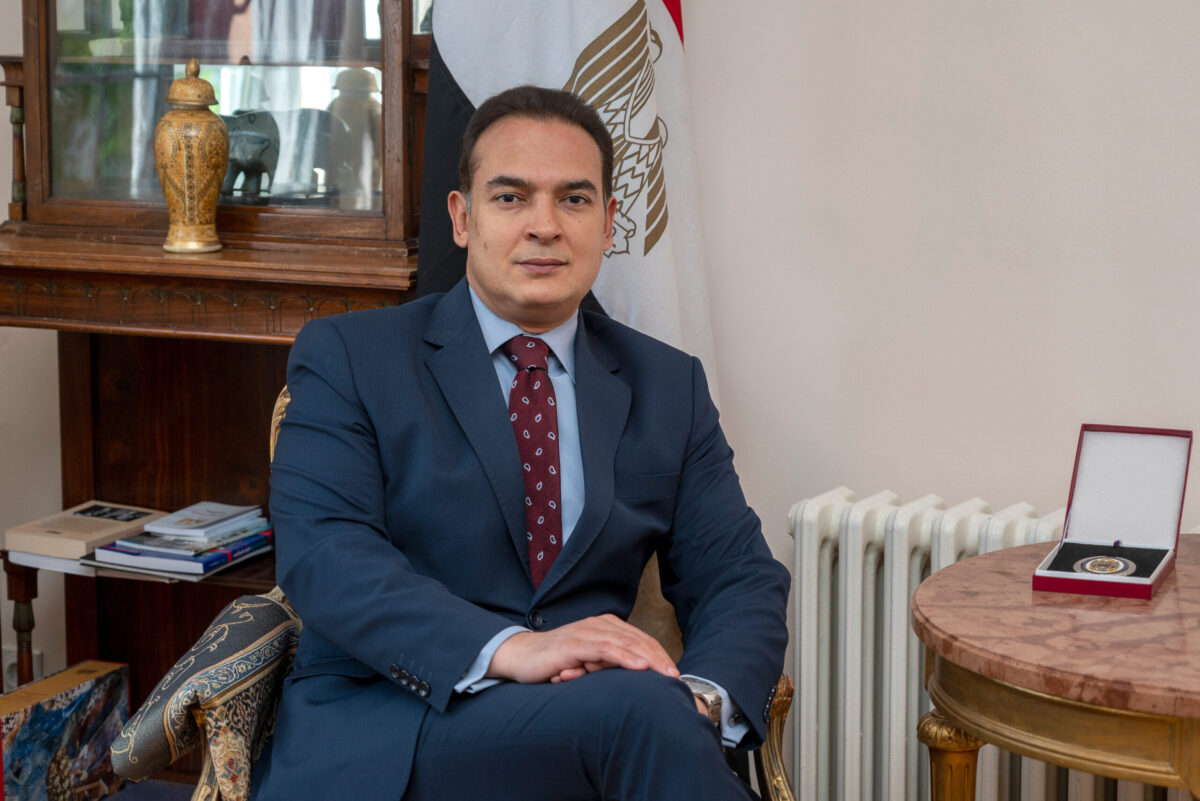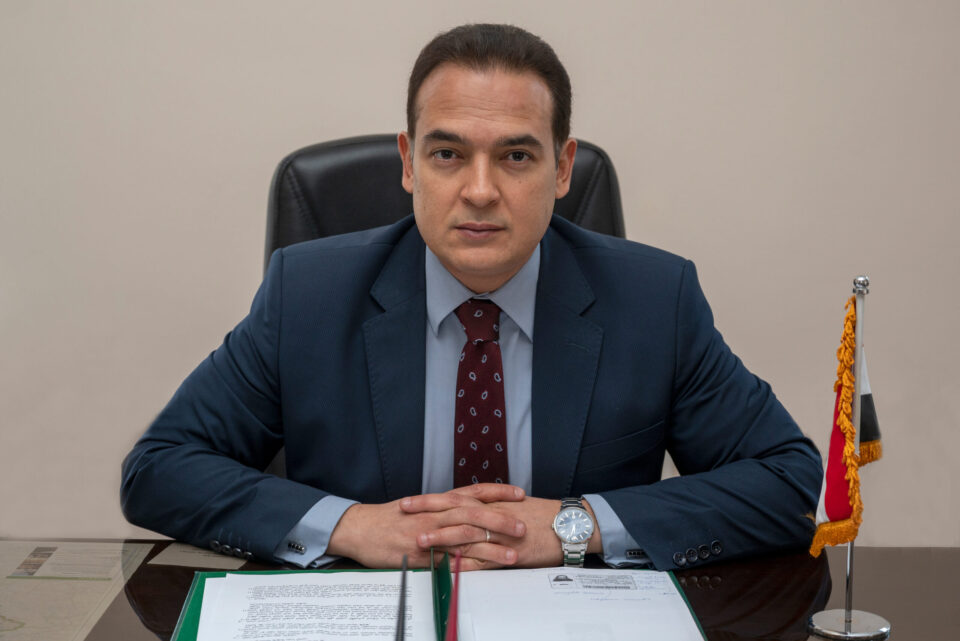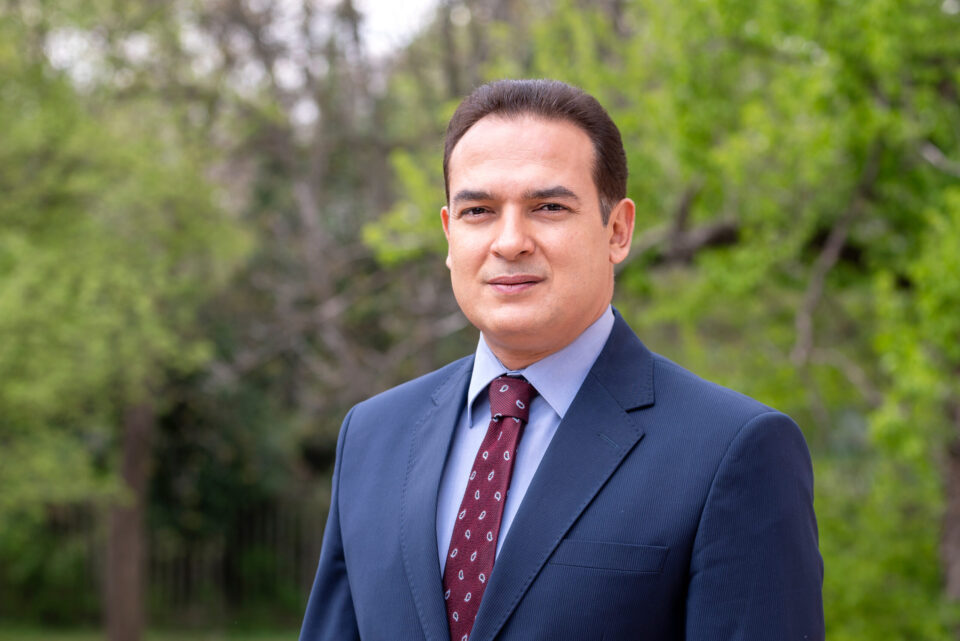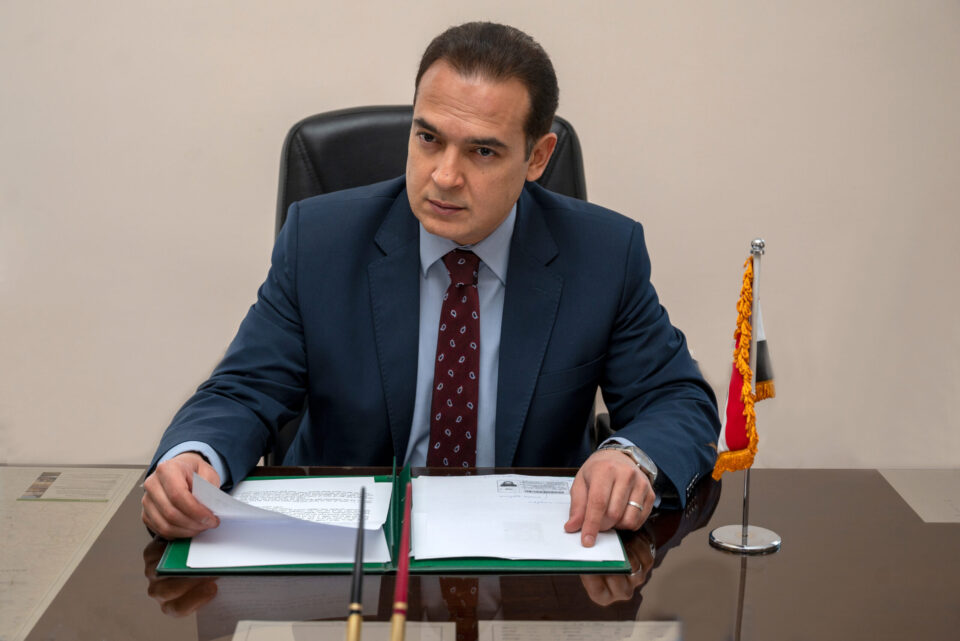Full steam ahead!
 Interview by: Žikica Milošević
Interview by: Žikica Milošević
Egypt has been under heavy and rapid transformation in the last 9 years, and the number of new projects is changing the face of the country which has become a full BRICS+ member. Tourism is getting accelerated with the opening of northern shores to the world, and economic and cultural development has ensued. About these and other things, we talked to H. E. Bassel Salah, the agile Ambassador of the Arab Republic of Egypt in Serbia.
Serbia and Egypt have had a long tradition of diplomatic relationships and cooperation. We remember King Peter II landing in Egypt in 1941 with his entourage. The relations were superb during the Non-Aligned era, a bit turbulent after that in some periods, but under President Sissi, they are once again very good. How do you rate our relations?
Egypt and Serbia maintained old diplomatic relations, which were established in 1908. These exceptional relations between Egypt and Serbia are based on strong ties in recent history, rooted in distinctive and identical views and goals towards the future of their countries and peoples, especially during the times of Presidents Nasser and Tito, as, the two countries played a major role in the establishment of the Non-Aligned Movement, and cooperated for the benefit of the entire independent and free world.
In this regard, I would like to refer to the historic visit of H.E. President Abdel Fattah Al-Sissi, President of the Arab Republic of Egypt to Serbia that took place from 19 to 22 July 2022, as an indicator of fostering friendly ties and the keenness of both countries to give a strong push to the bilateral relations in all spheres. This visit, was not only historic because it was the first for an Egyptian leader to Serbia for more than three decades, but also an essential one to put a solid base to many institutions from both sides to build and sustain a successful strategic partnership. This is clearly stated in the joint declaration on the strategic partnership between the two countries issued by the two Presidents. The visit witnessed the signing of several MoUs covering many fields, held both the bilateral Business Forum, and the joint Egyptian-Serbian business council, which allowed many Egyptian and Serbian businessmen to discuss and discover the promising areas of cooperation and start a new phase of bilateral economic cooperation between Egypt and Serbia.
In addition, Egyptian officials visited Serbia frequently, for instance in 2023; His Eminence Mufti of Egypt Shawky Allam visited Belgrade, the first visit by Egypt’s most distinguished religious personalities to Serbia, the governor of South Sinai Khaled Fouda, visited Serbia to discuss ways to strengthen tourism cooperation. Moreover, a delegation led by former Egyptian Foreign Affairs Minister and head of the Egyptian Council for Foreign Affairs, Ambassador Mohamed El Orabi attended an academic seminar on bilateral relations between Egypt and Serbia organized by the Serbian “International Institute of Politics and Economics”, to mark our celebration of 115th years of relations. H.E. Counsellor Hanafi Gebali, Speaker of the Parliament of Egypt also visited Serbia, where he conducted several intensive meetings with the Prime Minister of the Republic of Serbia, the Speaker of the Serbian Parliament and inaugurated the “Egipatska ulica” (Egypt Street) in Belgrade”.
 Economic cooperation and trade have increased. Is there any room for further improvement?
Economic cooperation and trade have increased. Is there any room for further improvement?
Egypt and Serbia have been working during the past few years on strengthening their economic cooperation to start with the key fields of cooperation. There is a high potential for intensifying economic relations, especially in the fields of agriculture, trade in agricultural products, investment, and ICT.
The Embassy is planning to focus on two main mechanisms in boosting economic cooperation with Serbia in the next two years, first: the Governmental mechanism represented in the Joint Committee for Economic, Technical, and Scientific Cooperation, its next session is planned to be organized in Cairo in the second half of year 2024, with participation of many concerned Egyptian and Serbian Ministries, to discuss the prospects of the economic cooperation between both countries. The second mechanism is the private sector represented in the Egyptian-Serbian Joint Business Council, whose next meeting should be held on the margins of the next meeting of the Joint Economic Committee.
H.E. President Abdel Fattah Al-Sissi, President of the Arab Republic of Egypt visited Serbia in 2022 after more than three decades, fostering bilateral ties
Furthermore, there are ongoing negotiations between both countries regarding concluding a Free Trade Agreement. During the visit of the H.E. President of Egypt to Serbia in 2022, both presidents announced the initiation of the FTA negotiations, and are looking forward to finalizing the negotiations to be ready for signing soon.
Moreover, both countries are keen to encourage businessmen from both sides to take advantage of many opportunities that can be exploited in areas such as infrastructure, agriculture, tourism, health care, household construction, and machinery industries.
 There are giant ongoing projects set to reshape Egypt – the New Egyptian Museum, the new airport, and the New Administrative Capital. There is even some news about the Qattara Depression project, resulting in a completely new lake, canal, and shore inside Egypt, which will enable new cities and new resorts – contributing largely to the economy and alleviating the pressure of overpopulation on the Nile shores. Tell us something about this gigantic transformation of Egypt.
There are giant ongoing projects set to reshape Egypt – the New Egyptian Museum, the new airport, and the New Administrative Capital. There is even some news about the Qattara Depression project, resulting in a completely new lake, canal, and shore inside Egypt, which will enable new cities and new resorts – contributing largely to the economy and alleviating the pressure of overpopulation on the Nile shores. Tell us something about this gigantic transformation of Egypt.
Since 2015, the overall Egyptian living experience has changed a lot. A chain positive reaction of social, political, and physical changes came to life in a magnitude incomparable to the preceding 30 years in Egypt. Social and political activism became evident in several events, through ambitious projects and plans of ongoing implementation.
The number of national mega projects you have mentioned contributed to greatly changing Egypt’s urban conditions and networks, as it aimed to enhance the competitiveness of the economy, create employment opportunities, and attract foreign and domestic private investments. With work underway by more than 1,000 companies and nearly 2m Egyptian workers, these national mega projects are contributing to a new chapter in Egypt’s economic progress.
Egypt’s population has been living under accelerated population growth for thousands of years, occupying less than 7% of the country’s total area. The country has faced numerous urbanization and population density issues over the past three decades. Building new cities has become a key strategic option to relieve pressure on existing cities and more fairly distribute resources.
Therefore, it was necessary to radically solve the crisis, redraw the map of Egypt’s population, and absorb the continuous overpopulation in the valley by eliminating slums and unsafe and unplanned areas, improving the quality of life of rural citizens through the national project for the development of Egyptian villages “a decent life”, and building new cities to redistribute the population away from the narrow strip of the Nile Valley.
The Northwest Coast Development Project will add 3 governorates and build such an infrastructure to relieve the overpopulation of Egypt and boost tourism
Tourist cooperation is at a high level – even now when the war is going on at the Egyptian border. Our tourists seem not to shy away but the Middle East troubles – we are loyal guests of Egypt. What is new about Egyptian tourism, like the Red Sea Riviera?
Egypt’s Red Sea Riviera is immensely popular with both tourists and locals alike for several reasons; its year-round warm weather, its white sand beaches, its awesome diving, and the fact that it’s away from all the hustle and bustle of city life. Most tourists usually book an all-inclusive trip to Hurghada or Sharm El-Sheikh through a tour agency, and while that obviously is a guaranteed great time, it’d be unfair to think that’s the extent of what the Red Sea Riviera has to offer.
First of all, let’s explain what exactly we’re talking about when we say ‘Red Sea Riviera’; Egypt’s riviera is divided between mainland Egypt and the Sinai Peninsula, and includes the Red Sea’s two gulfs, the Gulf of Suez and the Gulf of Aqaba. All of the towns/cities/resorts/parks you can stay at on the Riviera have one major thing in common: their awesome beaches and weather. Everything else (type of accommodation, activities, amenities, etc) differ from place to place.
The main places to stay on the Sinai Red Sea Riviera are. Ras Sedr, Ras Mohammed National Park, Sharm el Sheikh, Dahab, Nuweiba, Ras Shetan and Taba, and the main places to stay on Egypt’s mainland Red Sea Riviera are: Ain El Sokhna, El Gouna, Hurghada, Sahl Hasheesh, Makadi Bay, Soma Bay, Safaga, Marsa Alam and the Deep South.
For example; Ras Mohammed, is an Egyptian national park at the southernmost tip of Sinai, where the Red Sea’s Gulf of Aqaba meets the Gulf of Suez and the mixing of water leads to brightly-coloured, healthy coral reefs. Because of that, it is known for its breathtaking diving, considered the best in the whole world, so lots of people go for day trips to dive or snorkeling in the national park before it closes at sunset. The little bohemian town of Dahab is smaller, quieter and less commercial than its Red Sea Riviera neighbour Sharm El-Sheikh, but the diving is just as good. The main area of town is its seaside promenade, full of local and quirkily-named restaurants and shops.
Could you give us more details about the Northwest Coast development project?
The Northwest Coast Development Project is drawn by the National Strategic Plan for Urban Development in 2052, where the government has taken some serious steps. It coincides with the plan that is being implemented by the government to demarcate the future borders of the governorates, provide development and investment opportunities, and establish new urban communities to accommodate the population increase that is expected in the coming decades.
The Northwestern Coast extends from Al-Alamein to Salloum about 500 km and has a desert hinterland extending to 280 km, covering an area of about 160,000 km2. The importance of this developmental area lies in the fact that it is unique and distinctive. The Northwestern Coast and its various resources represent Egypt’s hope to absorb overpopulation in Egypt in the coming 40 years and will contribute to providing about 11 million job opportunities by 2052.
Additionally, the North Coast of Egypt is a popular destination due to its natural beauty, which includes stunning beaches, clear waters, and immaculate white sands. It is home to numerous stunning beaches, each with its distinct charm and personality, drawing tourists from all over the world to enjoy its dazzling white sand beaches, gorgeous sands, and crystal-clear waters. There are beaches to fit every taste and mood, from wide stretches of coastline lined with palm trees to quiet coves surrounded by craggy cliffs.
The mutual traditions between Egypt and Serbia serve as a bridge that connects these two nations across geographical boundaries
 In the end, the culture. Egypt is culturally very active in Serbia, and it represents a cultural powerhouse. What are new cultural dynamics in Egypt and where is the room for further cultural exchange?
In the end, the culture. Egypt is culturally very active in Serbia, and it represents a cultural powerhouse. What are new cultural dynamics in Egypt and where is the room for further cultural exchange?
It is known that culture connects people the most, and Egypt has many cultural sites that make our country the first destination included in the travel plans of most travellers. When it comes to the cultural exchange between Egypt and Serbia, the two countries enjoy great history which can easily open the floor to several and significant cooperation. We effectively apply the memorandum of understanding in the field of Culture between our two countries, and we are expecting to organize the “Serbian Cultural Week” in Egypt in the second half of the current year, as well as, we are also planning to encourage Egyptian folklore troupes to participate in several cultural events in Serbia soon.
Furthermore, both Egypt and Serbia have a rich tradition of folk music and dance that is integral to their cultural heritage. The rhythmic beats of traditional Egyptian music and the vibrant melodies of Serbian folk songs capture the essence of each country’s unique artistic expression.
The mutual traditions between Egypt and Serbia serve as a bridge that connects these two nations across geographical boundaries. Through a shared appreciation for family, music, dance, religion, and food, Egypt and Serbia demonstrate the enduring cultural ties that have endured through time, enriching the tapestry of human civilization with their collective legacy of traditions.